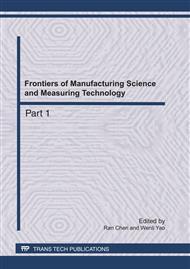[1]
Shamir, U., and Howard, C.D.D. (1979) An analytic approach to scheduling pipe replacement. J. AWWA, 71(5), 248-258.
DOI: 10.1002/j.1551-8833.1979.tb04345.x
Google Scholar
[2]
Kettler, A. J. & Goulter, I. C. (1985) An analysis of pipe breakage in urban water distribution networks. Can. J. Civ. Eng. 12 (2), 286–293. P 147–155.
DOI: 10.1139/l85-030
Google Scholar
[3]
McMullen, L. D., (1982). Advanced Concepts in Soil Evaluation for Exterior Pipeline Corrosion, Proceeding AWWA Annual Conference, Miami.
Google Scholar
[4]
Jacobs, P. & Karney, B. (1994) GIS development with application to cast iron water main brekage rates. In Proc. 2nd International Conference on Water Pipeline Systems, Edinburgh. Mechanical Engineering Publication Ltd, London.
Google Scholar
[5]
Andreou, S. A., Marks, D. H., and Clark, R. M. (1987). A new methodology for modeling break failure patterns in deteriorating water distribution systems: Theory., Advance in Water Resources, 10, 2-10.
DOI: 10.1016/0309-1708(87)90002-9
Google Scholar
[6]
Andreou, S. A., Marks, D. H., and Clark, R. M. (1987). A new methodology for modeling break failure patterns in deteriorating water distribution systems: Applications., Advance in Water Resources, 10, 11-20.
DOI: 10.1016/0309-1708(87)90003-0
Google Scholar
[7]
Malandain, J., Le Gauffre, P. and Miramond, M. (1998).
Google Scholar
[8]
Kleiner , Y. and Rajani, B. B. (2010), I-WARP: Individual Water Main Renewal Planner, NRCC-53221, Drinking Water Engineering and Science Discussion, v. 3, pp.25-41, January 01, (2010).
DOI: 10.5194/dwes-3-71-2010
Google Scholar
[9]
Davidson, J. W., and Goulter, I. C. (1994). A new probability distribution to model water main breakage patterns., Proc. 2nd Int. Conf. on Water Pipeline Systems, BHR Group Ltd., Edinburgh, Scotland.
Google Scholar
[10]
Goulter, I. C. & Kazemi, A. (1988) Spatial and temporal groupings of water main pipe breakage in Winnipeg. Can. J. Civ. Eng. 15 (1), 91–97.
DOI: 10.1139/l88-010
Google Scholar
[11]
Brémond, B., (1997). Statistical modeling as help in network renewal decision., European Commission Co-operation on Science and Technology (COST), Committee C3 – Diagnostics of Urban Infrastructure, Paris, France.
Google Scholar
[12]
Lei, J. (1997). Statistical approach for describing lifetimes of water mains – Case Trondheim Municipality., SINTEF Civil and Environmental Engineering, Report No. 22F007. 28, Trondheim, Norway.
Google Scholar
[13]
Quimpo, R. G., and U. M. Shamsi, (1991), Reliability Based Distribution System Maintenance, Journal of Water Resources Planning and Management, ASCE, 117, 3, pp.321-339, May/June.
DOI: 10.1061/(asce)0733-9496(1991)117:3(321)
Google Scholar
[14]
Mofid Gorji-Bandpy and Tahereh Gorji-Bandpy, (2007), Analysis of Pipe Breaks in Urban Water Distribution Network - Three Case Studies in Iran, International Conference on Sustainable Development: Challenges and Opportunities for GMS 12-14.
Google Scholar
[15]
Park S. (2008) Identifying the hazard characteristics of pipes in water distribution systems by using the proportional hazards model: theory. KSCE J Civil Engineering 8(6): 663–668.
DOI: 10.1007/bf02823557
Google Scholar


